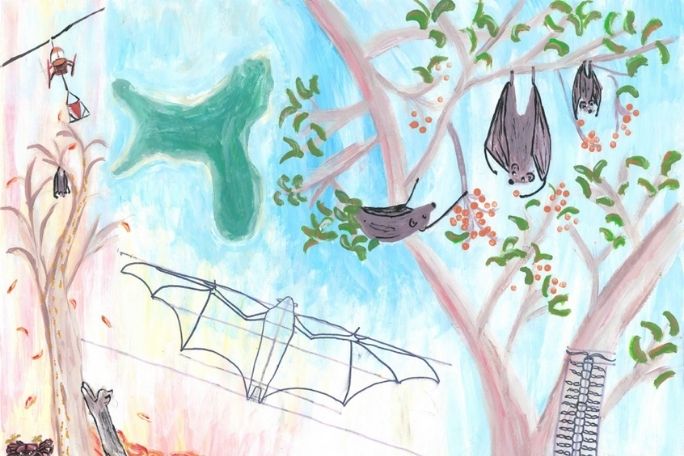Lesson summary
This is a STEAM lesson, which adds the Arts to STEM (Science, Technology, Engineering and Mathematics). To find out more about STEAM and STEM click here.
Students will explore and compare the scientific and artistic interpretation of a ‘true’ image by investigating traditional scientific images, scientific issues and the emotive nature of images or artwork. Students will explore how scaled scientific images are used to depict anatomical structure, whilst acknowledging that the use of data and scientific inquiry can also develop real-life understandings of an animal. For the main project within this lesson, students will identify and conduct research concerning an ‘ugly’ endangered native animal and communicate the ‘true’ image of this animal through an effective artwork.
Learning intentions:
Students will...
- complete accurate scientific drawings of cells or animals
- understand that loss of biodiversity is an issue in Australia
- understand the need for conservation of all native Australian species
- understand how images are able to transmit information to the viewer and can be manipulated to send a targeted message
- collect and analyse data for trends, and report findings.
Success criteria:
Students can...
- follow instructions to make a scientific drawing of a microscope slide or preserved specimen
- explain how the loss of biodiversity and conservation of Australian animals is an issue
- identify ways in which an image can send a message that affects the viewer emotionally
- conduct independent research to develop an understanding of an Australian animal
- share their knowledge of an Australian animal through an effective artwork.
Lesson guides and printables
Lesson details
Curriculum mapping
We encourage you to teach STEAM both through and between disciplines (transdisciplinary).
This lesson could be used across various strands of the curriculum, including Science and Visual Arts. Consider focusing on a curriculum strand that will complement other areas of learning you and your students are working on.
Syllabus outcomes: SC4-14LW, SC4-7WS, SC4-17CW, SC4-11PW, SC5-14LW, SC5-7WS, SC5-11PW, SC5-13ES, VAS4.1, VAS4.3, VAS4.4, VAS5.1, VAS5.3, VAS5.4
General capabilities: Literacy, Ethical Understanding, Critical and Creative Thinking, Personal and Social Capability.
Cross-curriculum priority: Sustainability
Relevant parts of Year 7 Science achievement standards: Students explain how biological diversity is ordered and organised. They explain how scientific responses are developed and can impact society. They select and use language and text features appropriately for their purpose and audience when communicating their ideas and findings.
Relevant parts of Year 8 Science achievement standards: Students explain the role of specialised cell structures and organelles in cellular function and analyse the relationship between structure and function at organ and body system levels. They analyse data and information to describe patterns, trends and relationships and identify anomalies. They select and use language and text features appropriately for their purpose when communicating their ideas, findings and arguments to specific audiences.
Relevant parts of Year 9 Science achievement standards: Students analyse the different ways in which science and society are interconnected. They analyse and connect data and information to identify and explain patterns, trends, relationships and anomalies. They select and use content, language and text features effectively to achieve their purpose when communicating their ideas, findings and arguments to specific audiences.
Unit of work: STEAM Made Simple – Secondary
Time required: 150 mins
Level of teacher scaffolding: Medium – the teacher will facilitate each section of the lesson and will play an important role in ensuring students understand the messages being sent in various images throughout the lesson. Students are encouraged to complete many sections independently.
Resources required
- Device capable of presenting a website to the class
- Extinction of Australian Mammals Article
- Kawaii Art Examples (or a device capable of projecting to the class)
- Powerful Images – Examples
- Resources Required (teacher copy)
- Scientific Drawing Example
- Scientific Drawing Instructions (one copy per student or a device capable of projecting to the class)
- Student Worksheet (one copy per student)
Skills
This lesson is designed to build students’ competencies in the following skills:
- Collaboration
- Creativity
- Critical thinking
- Global citizenship
- Problem solving
Additional info
STEAM Education:
Over recent years, the importance of STEM has been heavily promoted and discussed within fields of education. This has been within the context of ensuring that the next generation of students are provided with relevant knowledge and skills for the 21st century. STEM acknowledges the importance of the interrelated nature of science, technology, engineering and mathematics and the prominence of these skills in a world of continuous technological advancement.
What was missing from this original acronym, however, was an acknowledgement of the vital importance of artistic and creative thinking. The ability to think outside the box to develop artistic and creative solutions.
The relevance of art is integral to success in all of the original STEM areas, and so STEAM education is now moving to the forefront. Significant figures in science and technological advancement (notably Leonardo DaVinci, Albert Einstein and Steve Jobs) valued and applied the contribution of artistic skill into their work and art, design and creativity is also pivotal to success in industries such as marketing, advertising and promotion.
This is an original Cool+ lesson.


Welcome back!
Don't have an account yet?
Log in with:
By signing up to Cool.org you consent and agree to Cool's privacy policy to
store, manage and process your personal information. To read more, please see
our privacy policy here(Opens in new tab).
Create your free Cool.org account.
Many of our resources are free, with an option to upgrade to Cool+ for premium content.
Already have an account?
Sign up with:
By signing up to Cool.org you consent and agree to Cool's privacy policy to
store, manage and process your personal information. To read more, please see
our privacy policy here(Opens in new tab).